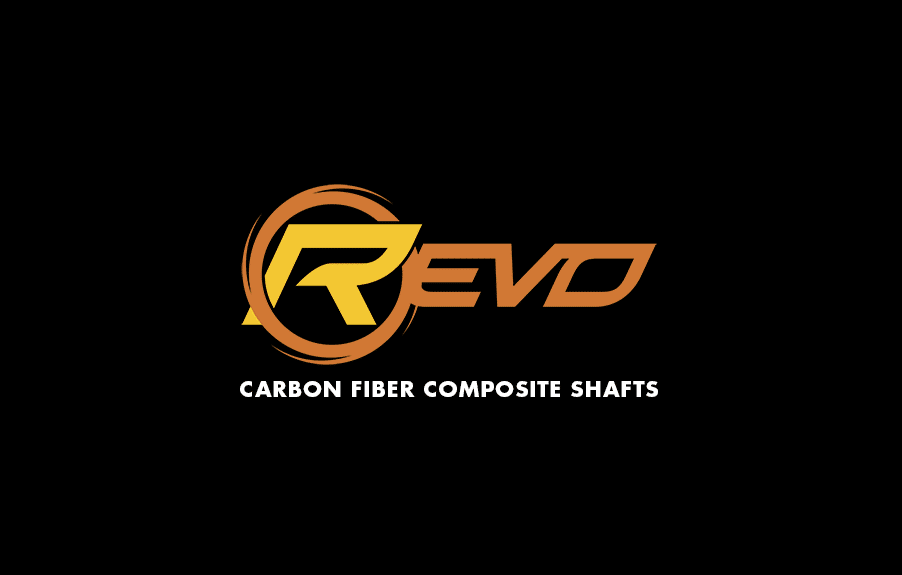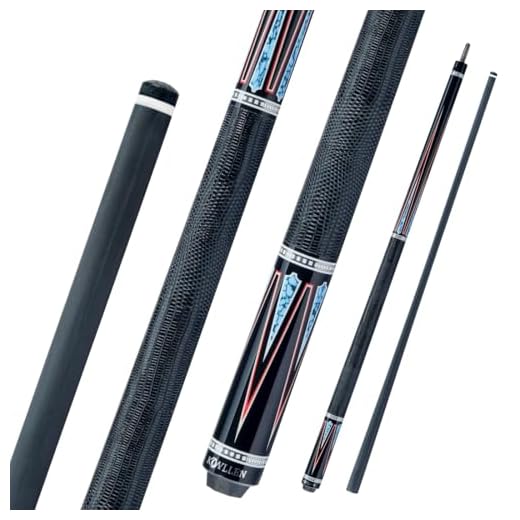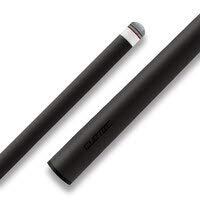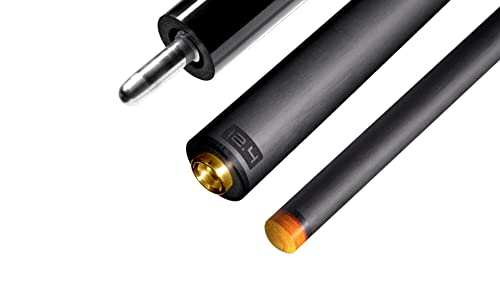
If you’re looking for some of the best carbon-fiber pool cues, here are five excellent choices — each with slightly different price-tiers, features and target players. First, a quick summary of why carbon fiber cues are worth considering, then the recommendations.





Table of Contents
Why go carbon-fiber?
- Carbon fibre construction offers low deflection, meaning when you apply sidespin (“English”) the cue-ball deviates less than with typical wood shafts, giving more accuracy.
- These cues resist warping, humidity and temperature shifts much better than wood, so their performance stays consistent.
- They often come with consistent weight & balance, durable surfaces, and lower maintenance requirements.
- The trade-off: they tend to cost more, and the “feel” may be different from traditional wood cues, so personal preference matters.
What to look for in a carbon-fiber cue
Recent reviews of carbon fiber cues highlight several advantages: such cues are more warp-resistant, stable in humidity, have lower deflection, and offer more consistent performance compared to many traditional wood cues.
Here are key specs/features to check:
- Shaft material & construction: true aerospace-grade or high-quality carbon fiber with good weave, not just “carbon-look” wraps.
- Tip size and taper: Many modern cues come with 11.5 mm, 11.8 mm, 12.5 mm options depending on your style (spin/control vs power).
- Weight: Most carbon cues now fall in the 18-21 oz range; lighter for finesse, heavier for power/strong breaks.
- Grip / wrap / handle style: Wrap or no-wrap, leather/microfiber grip or textured, depending on preference.
- Build quality, brand reputation & return policy; some cheaper carbon cues may not deliver the low deflection or true performance. “Anything not name brand … Most are not actual low deflection.”
Here are 5 best carbon fiber pool cues available in the market today;
Cuetec Cynergy 15K Carbon Composite Shaft: A very high-performance shaft built with 15K carbon fibre composite, designed for players who want tournament-level performance and low deflection.
Predator REVO Carbon Fiber Low‑Deflection Shaft: One of the elite shafts known for its low deflection and premium feel. Great if you already have a trusted butt and want to upgrade shaft specifically.
Bull Carbon BCSP Pool Cue: A full cue (not just shaft) from Bull Carbon, giving you a high quality full cue build with carbon fibre technology.
McDermott Defy Carbon‑Fiber Shaft Cue: High quality brand, carbon shaft version provides excellent feel/control.
Konllen Laser Series Carbon Fiber Pool Cue Stick: More budget-friendly carbon fiber cue; a good entry or secondary cue.
Which should you pick?
- If you’re a serious competitive player focusing on spin, English, position play: go with the Cuetec or Predator shafts (first two).
- If you want a full cue (shaft + butt) with carbon fibre tech and solid build: Bull Carbon or Meucci are excellent choices.
- If you’re improving / league player / or want to upgrade from wood without spending top-tier money: the Konllen model is very viable.
- Tip size, taper, shaft diameter, weight still matter a lot: Even the best carbon fibre cue won’t feel right if those specifications don’t match your style.
- Feel matters: Some players say carbon cues feel “different” (sometimes “dead” or “hollow”) compared to wood and require some adjustment.
- Make sure you try a cue if possible, or buy from a retailer with good return policy, so you can test how it feels in your stroke.
Conclusion
Carbon fiber cues have become the gold standard for performance and consistency, offering durability, low deflection, and precision that traditional wood cues can’t match. Whether you’re a seasoned competitor or an ambitious league player, upgrading to a carbon cue can dramatically improve your control, spin accuracy, and confidence at the table.
Among this year’s standouts, Cuetec’s Cynergy 15K and Predator’s REVO remain the top choices for professionals seeking tour-level accuracy. The Bull Carbon and McDermott Defy Carbon cues bridge high performance with style and affordability, while the Konllen Laser Carbon Series gives casual and intermediate players a solid entry point into carbon technology.
Ultimately, the best cue is the one that feels right in your hands — balanced, responsive, and suited to your playing style. Try different tapers, weights, and tip sizes to find your perfect match. With the right carbon-fiber cue, you’ll enjoy a smoother stroke, more consistent results, and a cue built to last for years of play.
FAQ
Are carbon fiber pool cues really better than wood cues?
Yes — for most players, carbon fiber cues offer clear performance advantages. They’re more resistant to warping, deliver low deflection for greater shot accuracy, and maintain consistent feel in different climates. That said, some players still prefer the “natural feedback” of traditional maple cues, so it’s partly personal preference.
What is “low deflection,” and why does it matter?
“Low deflection” means the cue ball deviates less from its intended line when you apply sidespin (English). Carbon fiber shafts are engineered with precise internal structures that reduce this unwanted curve, making them more forgiving and predictable — especially useful in competitive play.
How long do carbon fiber cues last?
A quality carbon fiber cue can easily last 10–20 years or more with proper care. The material doesn’t warp or crack like wood, and the shafts are built to maintain their straightness and smoothness even after thousands of shots.
Do carbon fiber cues require special maintenance?
Maintenance is minimal. Just wipe the shaft regularly with a microfiber cloth and cue-safe cleaner to remove chalk and oils. Avoid abrasive materials — they can dull the smooth finish. Most brands (like Predator and Cuetec) offer specific cleaning wipes for their shafts.
Are all carbon fiber cues the same?
No. Different brands use unique weave densities, tapers, and foam cores, which affect feedback, sound, and stiffness. For example, Predator’s REVO cues are known for ultra-low deflection and a crisp hit, while Cuetec’s Cynergy line feels slightly softer and more “woody.”
What tip size should I choose?
- 11.5 – 11.8 mm: Great for players who use a lot of English or finesse.
- 12.3 – 12.9 mm: More balanced — ideal for most players.
- 13 mm: Better for power players and those who prefer a traditional feel.
Your playing style and cue-ball control preferences determine what’s best.
Is a carbon fiber cue worth the investment for beginners?
If you’re serious about improving, absolutely. A carbon cue can shorten your learning curve by offering more consistency and precision. However, if you’re just starting casually, a mid-range wood cue or an entry-level carbon model (like the Konllen Laser Carbon Series) is a smart first step.
How much should I expect to spend?
Quality carbon fiber cues range from $350 to $800.
- Entry-level: Scorpion, Konllen ($150–$400)
- Mid-range: Meucci, Bull Carbon ($400–$650)
- Pro-level: Cuetec Cynergy, Predator REVO ($650–$900+)
Can I just buy a carbon fiber shaft instead of a full cue?
Yes — many players upgrade their existing cue butt with a carbon shaft. Brands like Predator REVO, Cuetec Cynergy, and McDermott Defy offer shafts that fit standard joint types. It’s a great way to modernize your setup without buying a full cue.
How do I choose between Predator and Cuetec?
- Predator REVO: Crisp hit, stiffer feel, ultra-low deflection, preferred by many professionals.
- Cuetec Cynergy: Slightly softer hit with a natural feel and excellent spin control — ideal for players transitioning from wood cues.
Both are excellent; the right choice depends on whether you prefer crisp precision (Predator) or smooth feedback (Cuetec).
Carbon-Fibre Cue Buyer’s Checklist
| Feature | What to check | Why it matters |
| Shaft / Tip Size | Look for options like ~11.5–11.8 mm (for finesse/spin) or ~12.5+ mm (for general/all-round). | The diameter and taper influence how the cue ball responds, especially with English/spin. |
| Cue Weight & Balance | Typical range ~18-21 oz. Make sure the balance feels comfortable and the weight suits your stroke. | A cue that’s too heavy or too light can throw off your comfort, control, and consistency. |
| Low-Deflection / Construction Quality | Ensure the shaft uses high-quality carbon fibre or composite tech, with verified low deflection specs. | One of the main benefits of carbon fibre cues is less deflection, giving more accurate shots. |
| Grip / Wrap / Handle Style | Check the wrap texture, material (leather, microfiber, no-wrap), how it feels in your hand. | Comfort and control in your grip translate to more consistent strokes and fewer miscues. |
| Durability & Maintenance | Carbon fibre should resist warping, humidity and require minimal maintenance. | A cue you don’t have to worry about makes practice and play more straightforward. |
| Budget & Value | Determine your budget, then check what features you get at that price. | You want the best performance for your money — sometimes less-expensive cues give solid value. |
| Try Before You Commit (if possible) | Test different weights, tapers, tip sizes, grip feels. | The “feel” is very personal — what works for someone else may not feel right to you. |
| Reputable Brand & Return Policy | Buy from known brands / retailers with good reviews and return policies. | Helps ensure you get genuine quality and recourse if the cue doesn’t suit you. |





